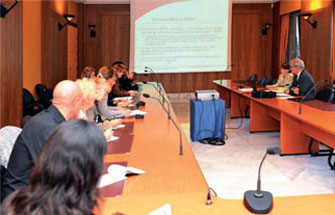 SEPA: The Principality activates migration towards the new European payment systems
SEPA: The Principality activates migration towards the new European payment systems
The creation of an internal market with payment in euros is under way. Monaco is committed to the single area comprising 32 European states and is making rapid progress.
After the introduction of the euro, this is the next and crucial stage that will make monetary union on a continental scale a concrete reality. Creation of the SEPA zone will enable all economic and social players – citizens, administrations, companies – to make and receive payments in euros throughout Europe in identical conditions, wherever they may be. SEPA payments will in the long run replace their national equivalents in 32 countries: the 27 members of the European Union plus Liechtenstein, Iceland, Norway, Switzerland and Monaco. Each country moves at its own pace: the joint deadline has still to be fixed by a European regulation expected in June 2011. The Principality of Monaco, which officially joined the SEPA zone only on 31 March 2009, is advancing rapidly towards the use of the new European modes of payment. True, the 80,000 bank transfers and direct debits in euros that pass through the Principality every day are a drop in the ocean compared to the 120 million transactions recorded at European level. Their migration is nevertheless important as a test of the operation of the European payment system, since half the movements in Monaco are trans-border operations.
Transfers already operational
Monaco’s banks already belong to the SCT (SEPA credit transfer) and SDD (SEPA direct debit) schemes; migration of the major order givers in the Principality has reached the development phase. Since February 2010 banks in Monaco have already been transmitting and receiving SEPA transfers. Since November 2010 they must also be in a position to receive SEPA direct debits. The Monaco Bankers Association (AMAF) has played a vital role as NASO (National Adherence Support Organization) coordinator, ensuring liaison with the European Payments Council to enable Monegasque banks to become part of the various SEPA payment systems within the deadlines laid down, and in particular to accept SEPA direct debits (SDD) before 1 November 2010. Sophie Vatrican, Deputy to the Budget and Treasury Director and co-chair of the national SEPA committee set up in October 2010, explains that “public administrations are involved in a significant proportion of payment operations in Monaco, making them a driving force behind the development of SEPA. Along with the public utilities and the telecom companies, they are in a position to create the dynamics that will launch a general movement. The Monegasque state has decided to lead the way: the public car-park authority has been chosen as the pilot administration. After a test phase, the first direct debits came into operation in May 2011. Other administrative departments will benefit from this experience and follow suit.”
Active communication
At the end of 2010 the SEPA project was presented in detail to the economic players in Monaco at two plenary sessions of the national committee. The committee then organized meetings of the Large Companies-Administrations and SME working parties to enable a certain number of companies to make progress reports on their situations, raise questions, and share experiences. The SEPA national committee also includes representatives of the employers’ federation, chartered accountants and IT service providers. “We advise small companies looking for more information on SEPA to contact these partners”, says Xavier O’Jeanson, the other co-chair of the committee. A third meeting of the national committee should be held before the end of the year, essentially to report on the results of the pilot operation carried out by the car-park authority. As soon as definite dates for integration of the processes are available the Monegasque committee will produce a final version of its information brochure.
The public car-park department as a pioneer
The switch to SEPA direct debit has a significant impact on the management methods and organization of the commercial arm of the department. The switch should be complete by the end of 2011.
Implementation of SEPA direct debit by the public car-park department? With the new rules for direct debit, it is now up to the service provider to prove that a client has granted authorization for money to be debited from his/her account. At the same time, all the information and direct debit file formats have been substantially modified. Finally, while retaining direct debit authorizations in paper format, the department has begun to digitize the new document required. All these major changes have led to significant adaptations of the information systems. The car-park department is also facing another constraint: like SEPA transfers, the new direct debits can only be processed using BIC and IBAN bank references. This means that the coordinates of bank accounts in Monaco must be converted to the new standards.
System launch in May
After a development and test phase, the public car parks launched the first SEPA direct debits in May for clients of the bank that is the car-park department’s service provider. Since June the system has been extended to other establishments in the Principality, and the switch should be complete by the end of 2011. The task is complicated by the fact that some of these banks are making their own changes to implement SEPA direct debit. In May Monaco’s public car parks had 13,400 clients using 117 different banks.





